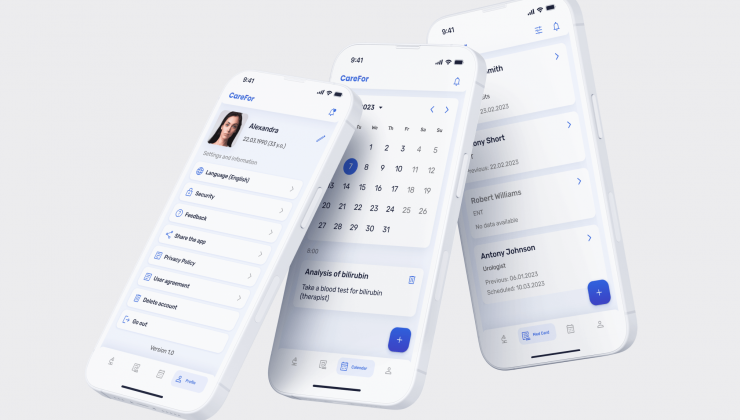Protecting user data is important in all industries, but when it comes to the healthcare sector, a sudden data breach and/or system failure can result in more than just patient dissatisfaction. In particular, organizations operating in this sector can face significant financial losses associated with the need to quickly recover from cyberattacks, as well as delays in providing diagnostic and treatment services to their patients. Below, we will consider the importance of cybersecurity in healthcare in detail.
The Rise of Cyber Threats in Healthcare
As practice shows, nowadays, protecting patients' private data is not only an ethical issue but also a legal necessity. Indeed, given the adoption of such international standards for the security of user data as GDPR, HIPAA, etc., their violation can result in healthcare organizations paying large fines, losing their reputation, and being banned from further activities.
Here are just a few statistics that explain the importance of ensuring the proper level of security in healthcare:
- Cybercrime costs in the healthcare sector amounted to $12 billion in 2021. (Cybersecurity Ventures)
- 76% of health protection organizations have experienced cyberattacks in 2022. (HIMSS)
- The cost of recovery after a cyberattack in health protection is on average $760,000. (Ponemon Institute)
And these are just three well-known facts out of thousands that have led to such negative consequences.
Types of Cyberattacks You Have to Know
Now, let’s consider the most widespread types of cyberattacks.
- Ransomware. Ransomware blocks all data stored on computers for regular users, opening access to it only after they pay a "penalty" in the amount specified by the hackers.
- Phishing. Phishing attacks usually appear in the form of emails and messages identical to those sent by well-known services and organizations. At the same time, they contain malicious links or program code that trick those who open them into sharing their confidential data with the attackers.
- Distributed denial of service (DDoS) attacks. Such attacks are aimed at "crashing" a system with excess traffic – this makes it inaccessible to regular users. This type of attack is either aimed at creating downtime in the organization that is being attacked or to distract the attention of employees of this organization during other network attacks.
- Internal threats. This type of hacking involves the employees of the company being attacked – they use their special access rights to sensitive data and steal it, either intentionally or accidentally, under the influence of other attackers.
- Advanced persistent threats (APT). These hacker attacks combine several approaches at once and provide attackers with constant access to the system. They are extremely difficult to detect, and their consequences are hard to quickly fix.
- Malware. Such software is used to intentionally harm systems, from stealing patient data to changing the approved scenarios of individual services. It is usually automatically downloaded to the victim's computer along with unverified files or emails.
- Supply chain attacks. These attacks are applied to suppliers that cooperate with a specific organization in the healthcare sector and are aimed at disrupting the usual scenarios of the supply chains in which they participate.
- Internet of Things (IoT) attacks. IoT attacks are applied to Internet of Things devices accordingly, such as sensors and other medical equipment. Their goals can range from changing their software algorithms to causing a complete failure.
These are just some of all possible cybersecurity issues in healthcare and, unfortunately, the approaches that hackers resort to are becoming more sophisticated and difficult to detect every day.

The Consequences of Cyberattacks on Healthcare
Even though organizations may be aware of the existing data security issues in healthcare, many of them do not fully understand the potential consequences of encountering them. That's why we decided to share with you some relevant situations that shook the whole world.
Massachusetts Health System (MHS)
In 2021, hackers performed a cyberattack on the Massachusetts Health System (MHS), stealing data from 6 million patients. They gained access to MHS computer systems through a software breach. As a result, MHS was forced to notify all 6 million affected patients of the breach and offer them free credit history monitoring services. The company also reported significant financial losses associated with expenses on investigations and data recovery.
In fact, preventing something like this was quite simple – all they had to do was schedule regular software updates, fix network vulnerabilities in time, and develop a comprehensive plan for responding to cyber incidents.
Baptist Health South Florida
In 2020, hackers from the Ryuk group blocked the operation of the computer tomography (CT) system at Baptist Health South Florida, demanding a ransom of $10 million. The hackers used ransomware that encrypts data on computers, making it inaccessible to users. Due to the incident, Baptist Health South Florida was forced to close the radiology department for several days, which resulted in delays in the diagnosis and treatment of patients. The company also paid hackers $4.5 million to decrypt its data.
From our point of view, this case reinforces the insecurity of using consumer software and the importance of data backup. Companies should also consider using cyber insurance to protect against financial losses when they face cyberattacks.
WannaCry
In 2017, the WannaCry cyberattack affected computer systems in hospitals around the world, encrypting data and demanding ransom. WannaCry exploited Microsoft Windows software that had not been updated by many organizations. The WannaCry attack cost billions of dollars in losses, forcing hospitals to close branches, stop operations, and pay ransom to the hackers.
Overall, the WannaCry attack highlighted the importance of keeping software up to date and using security measures to protect against ongoing threats.
Anthem
In 2015, hackers gained access to the computer systems of the Anthem insurance company, stealing data from 78 million people. They used a phishing method to trick Anthem employees into giving them access to the company's network. As a result, Anthem was forced to notify all 78 million affected people of the breach and offer them free credit monitoring services. The company also reported significant financial losses through expenses on data recovery.
Overall, this negative experience from one company demonstrates the importance of training employees in cybersecurity and introducing a set of procedures to protect them from phishing attacks.
How to Prevent Data Leakage and System Failures in the Healthcare Sector
Now, we propose you consider cybersecurity best practices aimed at the prevention of data breaches.

Risk Assessments
The first step for any healthcare organization is to conduct a data breach risk assessment to identify vulnerabilities (due to outdated software, human error, etc.) in the system. This allows companies to respond to threats proactively by implementing pre-planned scenarios to prevent and/or mitigate their negative consequences and return their systems to previous operating scenarios.
Vulnerability Management
Companies should also prepare comprehensive vulnerability management plans that will help them identify and fix vulnerabilities in their systems in real time, long before they are damaged by cyberattacks. Typically, these plans involve implementing specialized monitoring solutions, conducting regular bottleneck detection and recovery measures, as well as planning in-time software updates.
Incident Response Planning
In addition to preventive cybersecurity medical measures, healthcare organizations should also prepare for what they will do when they face cyberattacks firsthand. Specifically, in addition to timely detection of an attack, they should have a well-thought-out plan to restrain it and eliminate its consequences. These organizations should also prepare protocols for notifying stakeholders so that they can take immediate actions on their endpoints and, thus, minimize the negative impact of a cyberattack.
Employee Training and Awareness
Finally, healthcare companies must continually raise awareness among their personnel to minimize the risks of cyberattacks in which they may unwittingly participate. To do this, such companies typically implement their own training methods and approaches that inform employees about basic principles of hospital cybersecurity, i.e., about how they can independently protect sensitive data, as well as recognize and prevent types of attacks.
Developing a Custom, Highly-Secure Solution for Patients by WEZOM
In this paragraph, we would like to consider a particular case of custom software development, which complied with generally accepted healthcare security standards and policies.

In particular, last year, one of our clients approached us with the goal of creating an MVP, mobile software for people who care about their health and regularly undergo medical analyses. The created software was supposed to simplify the procedure for scheduling visits to doctors, store doctor's appointments and examination results, and also allow its users to track the dynamics of these results on a timeline.
As the main tech stack, we chose Flutter and Laravel – secure and reliable frameworks that significantly speed up the development process. We also managed to achieve optimal team’s productivity by combining the prototyping and technical design stages while implementing advanced AES cybersecurity measures to ensure data protection throughout development. As a result, the first version of the product was launched just five months after the first contact with the client. At the same time, we did not have to neglect compliance with the policies and security standards typical for healthcare software to protect client data from the threats listed in the paragraphs above..
Currently, this MVP is actively promoted in app stores, and we are working on its full version. You can learn more about this case here:
Right Choice for Healthcare Solution Development
As practice shows, in addition to implementing internal measures for IT security in healthcare, it is crucial for companies in this sector to use reliable software that would reduce the risk of leakage of critical data from the system.
If you are interested in developing such a software solution, you can contact us as a company with many years of experience in creating applications and services for medical organizations. We will provide your idea with the best balance between functionality, ease of use, and security of its implementation.
